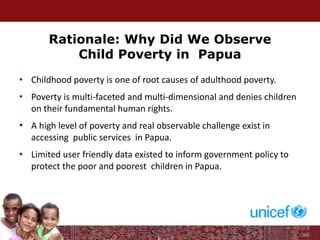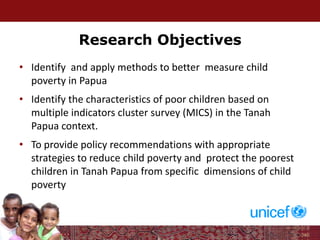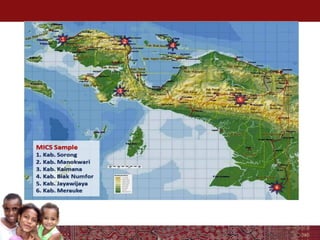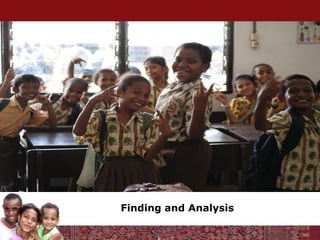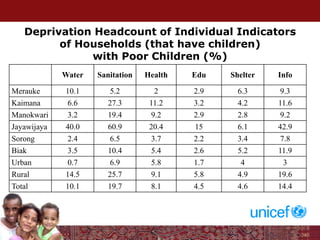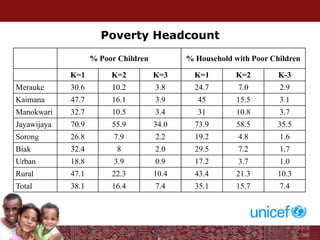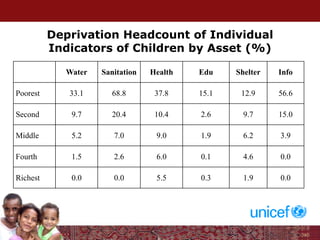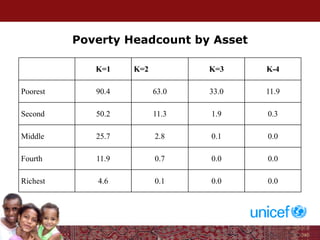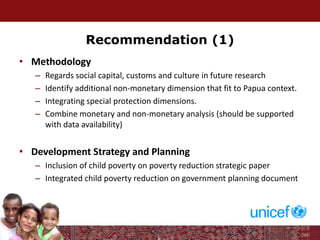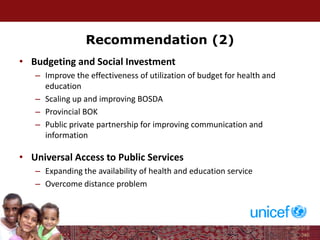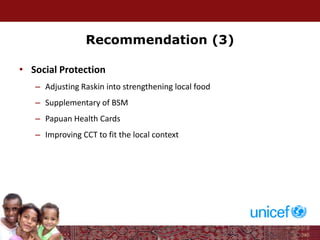Multidimensional Child Poverty in Papua
- 1. Multidimensional Child Poverty in Papua: Empirical Evidence from 6 Districts Erlangga Agustino Landiyanto UNICEF Papua Office, Indonesia Child Poverty and Social Protection Conference 10–11 September 2013
- 2. Rationale: Why Did We Observe Child Poverty in Papua • Childhood poverty is one of root causes of adulthood poverty. • Poverty is multi-faceted and multi-dimensional and denies children on their fundamental human rights. • A high level of poverty and real observable challenge exist in accessing public services in Papua. • Limited user friendly data existed to inform government policy to protect the poor and poorest children in Papua.
- 3. Research Objectives • Identify and apply methods to better measure child poverty in Papua • Identify the characteristics of poor children based on multiple indicators cluster survey (MICS) in the Tanah Papua context. • To provide policy recommendations with appropriate strategies to reduce child poverty and protect the poorest children in Tanah Papua from specific dimensions of child poverty
- 4. Indicators, Data and Methodology
- 5. Dimensions for Child Poverty (Gordon et al, 2003) • Severe Water Deprivation: Children who only has access to surface water • Severe Deprivation of Sanitation Facilities: Children who had no access to a toilet • Severe health Deprivation: Children had not been immunized against any diseases • Severe Education Deprivation: Children aged between 7 and 18 who never been to school (%) • Severe Shelter Deprivation: Children in dwellings more than five person per-room (%) • Severe Information Deprivation: children aged between 3 and 18 with no access to radio or television and communication (%)
- 8. Correlation among Child Poverty Indicators (Children) Water Sanitation Health Edu Shelter Info Water 1 Sanitation .312** 1 Health .285** .262** 1 Education .246** .230** .b 1 Shelter .037** .103** .025 .073** 1 Information .296** .405** .272** .259** .129** 1
- 9. Deprivation Headcount of Individual Indicators of Children (%) Water Sanitation Health Edu Shelter Info Merauke 12.3 7.4 3.7 2.6 10.7 11.5 Kaimana 6.8 29.6 19.1 2.9 5.8 12.4 Manokwari 3.3 20.3 17.3 2.2 5.1 10 Jayawijaya 38.7 58.1 34.9 16.2 8.8 45.5 Sorong 3.6 9.4 8.3 1.8 5.8 12 Biak 4.2 11.1 7.4 2.1 7.6 12.7 Urban 1 7.5 9.7 1.3 6.2 3.1 Rural 14.9 27.1 16.9 5.4 7.8 21.9 Total 10.5 20.9 14.5 4.1 7.3 16
- 10. Correlation among Child Poverty Indicators (Households with Children) Water Sanitation Health Edu Shelter Info Water 1 Sanitation .348** 1 Health .287** .335** 1 Education .246** .252** .c 1 Shelter .034* .084** -.015 .084** 1 Information .303** .438** .336** .264** .110** 1
- 11. Deprivation Headcount of Individual Indicators of Households (that have children) with Poor Children (%) Water Sanitation Health Edu Shelter Info Merauke 10.1 5.2 2 2.9 6.3 9.3 Kaimana 6.6 27.3 11.2 3.2 4.2 11.6 Manokwari 3.2 19.4 9.2 2.9 2.8 9.2 Jayawijaya 40.0 60.9 20.4 15 6.1 42.9 Sorong 2.4 6.5 3.7 2.2 3.4 7.8 Biak 3.5 10.4 5.4 2.6 5.2 11.9 Urban 0.7 6.9 5.8 1.7 4 3 Rural 14.5 25.7 9.1 5.8 4.9 19.6 Total 10.1 19.7 8.1 4.5 4.6 14.4
- 12. Poverty Headcount % Poor Children % Household with Poor Children K=1 K=2 K=3 K=1 K=2 K-3 Merauke 30.6 10.2 3.8 24.7 7.0 2.9 Kaimana 47.7 16.1 3.9 45 15.5 3.1 Manokwari 32.7 10.5 3.4 31 10.8 3.7 Jayawijaya 70.9 55.9 34.0 73.9 58.5 35.5 Sorong 26.8 7.9 2.2 19.2 4.8 1.6 Biak 32.4 8 2.0 29.5 7.2 1.7 Urban 18.8 3.9 0.9 17.2 3.7 1.0 Rural 47.1 22.3 10.4 43.4 21.3 10.3 Total 38.1 16.4 7.4 35.1 15.7 7.4
- 13. Deprivation Headcount of Individual Indicators of Children by Asset (%) Water Sanitation Health Edu Shelter Info Poorest 33.1 68.8 37.8 15.1 12.9 56.6 Second 9.7 20.4 10.4 2.6 9.7 15.0 Middle 5.2 7.0 9.0 1.9 6.2 3.9 Fourth 1.5 2.6 6.0 0.1 4.6 0.0 Richest 0.0 0.0 5.5 0.3 1.9 0.0
- 14. Poverty Headcount by Asset K=1 K=2 K=3 K-4 Poorest 90.4 63.0 33.0 11.9 Second 50.2 11.3 1.9 0.3 Middle 25.7 2.8 0.1 0.0 Fourth 11.9 0.7 0.0 0.0 Richest 4.6 0.1 0.0 0.0
- 16. Recommendation (1) • Methodology – Regards social capital, customs and culture in future research – Identify additional non-monetary dimension that fit to Papua context. – Integrating special protection dimensions. – Combine monetary and non-monetary analysis (should be supported with data availability) • Development Strategy and Planning – Inclusion of child poverty on poverty reduction strategic paper – Integrated child poverty reduction on government planning document
- 17. Recommendation (2) • Budgeting and Social Investment – Improve the effectiveness of utilization of budget for health and education – Scaling up and improving BOSDA – Provincial BOK – Public private partnership for improving communication and information • Universal Access to Public Services – Expanding the availability of health and education service – Overcome distance problem
- 18. Recommendation (3) • Social Protection – Adjusting Raskin into strengthening local food – Supplementary of BSM – Papuan Health Cards – Improving CCT to fit the local context
- 19. Thank You!


